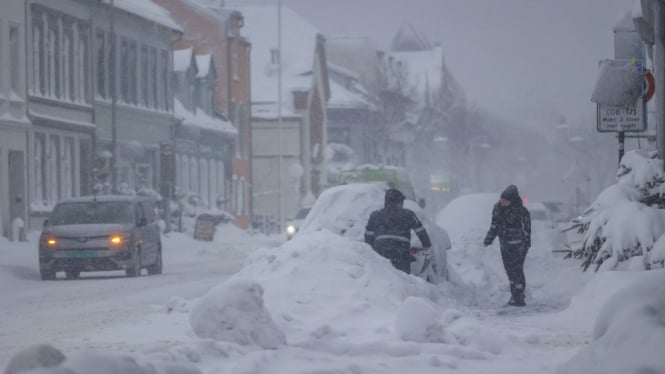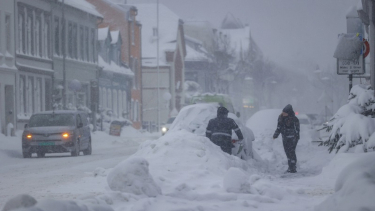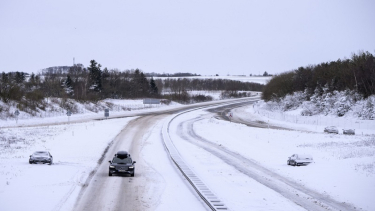Europe Freezes as Finland and Sweden Freeze at -40 Degrees Celsius
- Tor Erik Schrøder/NTB Scanpix via AP
Europe – Europe has experienced contrasting cold weather in recent days, with extreme cold temperatures and snowfall disrupting transportation and closing schools in Scandinavia, while strong winds and heavy rain in western Europe caused flooding and at least one death.
Europe experienced extreme cold temperatures after a very hot and dry summer, and a warm fall.
After that, Europe was hit by heavy snowfall and flooding occurred in several countries in Europe, with Finland setting a new temperature record of -44.3 degrees Celsius on Friday, January 5, 2024.
Jalan yang menghubungi kota Odum and Mejlby, Denmark, dilapisi salju tebal
- Bo Amstrup/Ritzau Scanpix via AP
Temperatures dropped to a record low of -44.3 degrees Celsius in Finland's northwestern region of Lapland on Friday morning, public broadcaster YLE said, citing the Finnish Meteorological Institute.
The institute noted that temperatures below -42 degrees Celsius have only occurred three times this century.
The extreme weather also caused transportation disruptions in Finland, including in the capital Helsinki.
The Finnish National Railway Service (VR) suspended train services on dozens of routes due to the extreme cold weather. The extreme weather in Finland caused electricity consumption to increase and reach record highs over the past few days.
On Friday, electricity prices, which are moving due to high demand, are expected to reach a record high of 2.35 euros per kilowatt-hour.
Meanwhile, cold weather in Sweden has caused temperatures in the north to drop below -40 degrees Celsius. The lowest temperature recorded at Sweden's northernmost weather station, Naimakka, was -43.8 degrees Celsius, the Swedish Meteorological and Hydrological Institute (SHMI) said.
The extreme cold and snowfall also caused chaos on many highways in Sweden, public broadcaster SVT reported.
Extremely cold temperatures, snow and strong winds disrupted transportation across the Nordic region, with some bridges closed and some train and ferry services suspended. Some schools in Scandinavia were closed.
Police in most parts of Denmark urged motorists to avoid unnecessary travel as wind and snow hit the north and west of the country. Norway experienced its coldest weather since 2020 on Friday.
Temperatures are expected to drop to -20 degrees Celsius in Oslo and -30 degrees Celsius in eastern Norway, public broadcaster NHK said.
Denmark, another Scandinavian country, also experienced sub-zero temperatures on Friday, after heavy snowfall two days earlier, according to public broadcaster DR.
In addition, the European Union's Copernicus Emergency Management Service reported that flooding is still occurring in several German states including Lower Saxony, Saarland, and Thuringia, as well as Nord-Pas-de-Calais in France, affecting tens of thousands of hectares of land.
A wave of cold air from Siberia and the Arctic region also hit western Russia, with temperatures in Moscow and other regions plummeting to minus 30 degrees Celsius (minus 22 F), well below average temperatures in early January.
Officials in Moscow, St. Petersburg and other regions have issued orange weather warnings, alerting residents to possible health risks. Mild but wet and windy conditions prevailed further south, where storms wreaked havoc in parts of Western Europe.
In the United Kingdom (UK), a driver was killed after a tree fell on his car in western England. Gloucestershire police said the man died in the incident near the town of Kemble on Tuesday afternoon.
The storm, named Henk by the official weather agencies of the UK, Ireland and the Netherlands, has caused power cuts, transportation problems, property damage and disruption across the UK.
More than 300 flood warnings were in place across England and Wales on Wednesday, while 10,000 homes were still without power.
A major flood warning, meaning danger to life, was declared on the River Nene at Northampton in central England. Some residents were evacuated from houseboats and caravans near the Billing Aquadrome.
The rail network in the UK was hit by flooding and power cuts, with many operators reporting ongoing problems on the way home from work on Wednesday morning.
The strongest gales in the UK were recorded on the Isle of Wight, just off the coast in southern England, with wind speeds reaching 94 miles per hour (151 kilometers per hour).
The European Union's Civil Protection Mechanism was activated to help flood victims in Germany and France. Pumps, flood barriers and vehicles were deployed to flood-affected areas. Heavy rain and flooding also impacted rail services and road traffic in some areas of the United Kingdom.




























